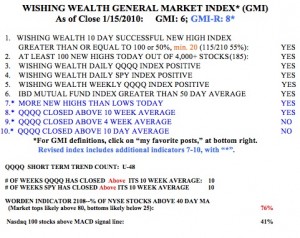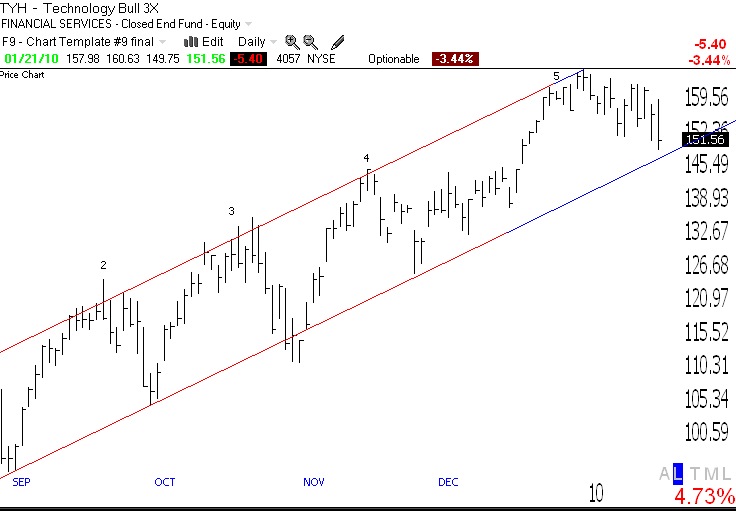The vicious high volume break in the tech stock short term up-trend is a major sign of weakness. The GMI is down to +2, for the first time since the decline last November. This is not the time to be brave; I must conserve my capital. I will lighten up this week, move up my sell stops, and wait to see if the decline deepens. Given that the longer term up-trend remains intact, I will not go into cash in my conservative university pension funds.
Tech Stocks Decline, Will Channel Hold?
Thus far, tech stocks, as measured by the ultra 3X ETF, TYH, are declining within the channel I have been watching for several weeks. The question, which my stock buddy, Judy, raised when I first posted the channel was, will the bottom of the channel hold as it has in the past? No one knows. The key for me is to wait for the reversal, and to then wade in slowly, with stops below the low of the bounce. Meanwhile, the Worden T2108 Indicator is now in neutral territory, at 58%. Only 19% of the NASDAQ 100 stocks have a MACD that is above its signal line, the lowest percentage since last November’s decline. The low in this indicator last November was 9%. The key for me is to remain defensive, and to cut losses before they grow too large.
NASDAQ 100 Index Still in Up-trend; QLD and TYH beat most NASDAQ 100 stocks again!
The GMI is still at 6 although the more sensitive GMI-R has declined to 8. Still, there were 185 new highs in my universe of 4,000 stocks on Friday.  The Worden T2108 Indicator is now at 76%, within neutral territory and down from the high of 84% last week. But only 41% of the Nasdaq 100 stocks had their MACD above their signal line, reflecting the weakness in tech stocks. Still, the SPY and QQQQ have closed above their 10 week averages for 10 weeks. During that time, the QQQQ increased +11%, QLD by +23% and TYH by +36%. The TYH beat all but 3 of the Nasdaq 100 stocks and QLD beat all but 12 of them. I repeatedly learn the virtue of just holding the QLD or TYH ETF’s rather than trying to find the few individual stocks that beat these amazing ultra ETF’s.
The Worden T2108 Indicator is now at 76%, within neutral territory and down from the high of 84% last week. But only 41% of the Nasdaq 100 stocks had their MACD above their signal line, reflecting the weakness in tech stocks. Still, the SPY and QQQQ have closed above their 10 week averages for 10 weeks. During that time, the QQQQ increased +11%, QLD by +23% and TYH by +36%. The TYH beat all but 3 of the Nasdaq 100 stocks and QLD beat all but 12 of them. I repeatedly learn the virtue of just holding the QLD or TYH ETF’s rather than trying to find the few individual stocks that beat these amazing ultra ETF’s.
